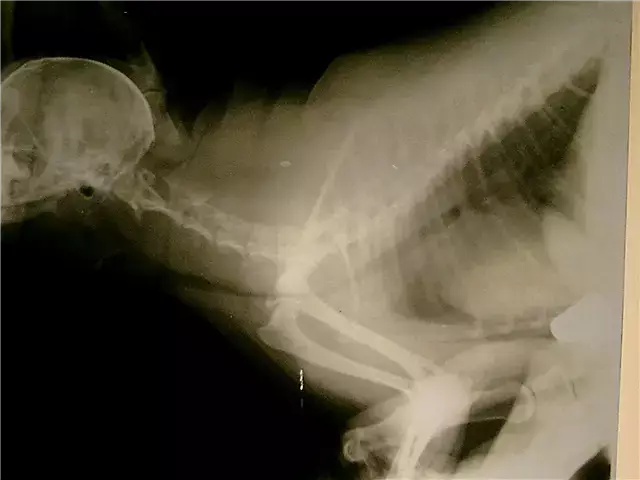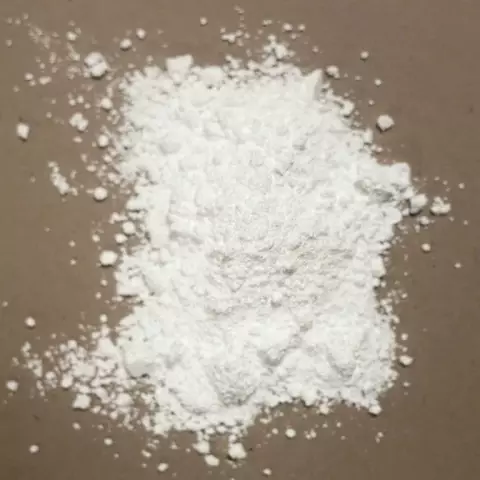- Author Rachel Wainwright [email protected].
- Public 2023-12-15 07:39.
- Last modified 2025-11-02 20:14.
Antithrombin III human
Instructions for use:
- 1. Release form and composition
- 2. Indications for use
- 3. Contraindications
- 4. Method of application and dosage
- 5. Side effects
- 6. Special instructions
- 7. Drug interactions
- 8. Analogs
- 9. Terms and conditions of storage
- 10. Terms of dispensing from pharmacies
Prices in online pharmacies:
from 17,000 rubles.
Buy

Human antithrombin III is a preparation of antithrombin III, a direct-acting anticoagulant.
Release form and composition
Dosage form - lyophilisate for preparation of solution for infusion: loose solid mass or powder of pale green or pale yellow color (500 international units (IU) in vials, in a cardboard box 1 vial and a kit for dissolution and administration: 1 vial of solvent (10 ml), filter needle, disposable needle, adapter needle, butterfly needle, airway needle; 1000 IU each in vials, 1 vial in a cardboard box and a set for dissolution and administration: 1 vial of solvent (20 ml), filter needle, disposable needle, adapter needle, butterfly needle, airway needle).
The active substance of human antithrombin III is antithrombin III, in 1 ml of the finished solution - 50 IU (1 IU of the solution is equivalent to the activity of antithrombin III in 1 ml of normal fresh human plasma), total protein is 20-50 mg.
Auxiliary components: tris (hydroxymethyl) aminomethane, sodium chloride, dextrose monohydrate, sodium citrate dihydrate.
Solvent: water for injection.
Indications for use
The use of human antithrombin III is indicated for patients with congenital or acquired deficiency of antithrombin III in blood plasma. Acquired antithrombin deficiency can result from various clinical disorders, including increased intake or loss of protein, impaired antithrombin synthesis.
The drug is prescribed for the prevention of thrombotic and thromboembolic complications in patients with plasma antithrombin activity less than 70% of the established norm.
Indications for administration:
- surgical operations in patients with congenital antithrombin III deficiency;
- the period of pregnancy and childbirth in patients with congenital antithrombin III deficiency;
- thrombosis in patients with inflammatory diseases of the bladder or nephrotic syndrome, or the risk of its development;
- syndrome of disseminated intravascular coagulation or the risk of its development with septic complications, concomitant trauma, preeclampsia, shock and other conditions associated with acute consumption coagulopathy;
- surgery or bleeding in severe liver failure, especially in patients on therapy with coagulation factor concentrates;
- lack or insufficient response to heparin.
Contraindications
- an indication of a history of heparin-induced thrombocytopenia;
- age up to 6 years;
- hypersensitivity to the components of the drug.
During pregnancy and breastfeeding, Antithrombin III human can be prescribed only for health reasons.
Method of administration and dosage
The lyophilisate is intended for intravenous (IV) drip administration.
The infusion solution is prepared before direct administration, using the kit supplied for dissolution and administration and strictly observing the rules of asepsis and antiseptics. After heating the still closed bottle with the solvent to a temperature not exceeding 37 ° C, free the bottles with the lyophilisate and the solvent from the protective caps, the rubber stoppers on each of the bottles should be disinfected. After removing the protective cap from the adapter needle at one end, pierce the cork of the solvent bottle with the needle. Without touching the needle, remove the protective cap from the other end. Then, turning the vial with the solvent, pierce the rubber stopper of the vial with the lyophilisate with the free end of the needle and, under the action of vacuum, the solvent will enter the vial with the lyophilisate. After removing the needle from the vial with the drug,light rotation or swaying should accelerate the dissolution of the lyophilisate. For sedimentation of the formed foam after complete dissolution of the drug, the cork of the bottle is pierced with an airway needle and then removed. The prepared solution is taken with a disposable sterile syringe with a filter needle. Having visually examined the solution and making sure that there is no turbidity or foreign inclusions, you should change the filter needle to a butterfly needle. Then you should slowly in / in the solution, not exceeding the maximum permissible injection rate - 5 ml per minute. Unused solution must be disposed of in accordance with established rules. The prepared solution is taken with a disposable sterile syringe with a filter needle. Having visually examined the solution and making sure that there is no turbidity or foreign inclusions, you should change the filter needle to a butterfly needle. Then you should slowly in / in the solution, not exceeding the maximum permissible injection rate - 5 ml per minute. Unused solution must be disposed of in accordance with established rules. The prepared solution is taken with a disposable sterile syringe with a filter needle. Having visually examined the solution and making sure that there is no turbidity or foreign inclusions, you should change the filter needle to a butterfly needle. Then you should slowly in / in the solution, not exceeding the maximum permissible injection rate - 5 ml per minute. Unused solution must be disposed of in accordance with established rules.
Prescribing and treatment should be carried out by a physician with experience in the treatment of antithrombin deficiency.
The dose for congenital failure is selected for each patient individually, taking into account the family history of thromboembolic conditions, the results of laboratory tests and existing clinical risk factors.
The initial dose for congenital insufficiency is usually prescribed at the rate of 30-50 IU per 1 kg of body weight. Further, a single dose, frequency of administration and duration of treatment are adapted to the indicators of biochemical studies and the clinical state of the patient.
The dose, frequency of administration and the period of replacement therapy for each patient with acquired deficiency is determined on the basis of biochemical parameters of the level of antithrombin in plasma, taking into account the diagnosis of the underlying disease, the existing signs of increased metabolism of antithrombin and the severity of the clinical condition.
Based on empirical data, when calculating the required dose, a correspondence is used in which to increase the activity of antithrombin in human plasma by approximately 2%, it is necessary to introduce 1 IU of antithrombin per 1 kg of body weight.
To determine the initial dose of the drug (IU), the patient's nominal body weight must be multiplied by the difference between the target and the initial level of antithrombin activity (which are expressed as a percentage) and multiplied by 0.5.
The initial target activity of antithrombin should be sufficient to achieve the target activity of antithrombin in replacement therapy of the established pathology. To maintain an effective level, laboratory measurements of antithrombin activity should be carried out at least 2 times a day, preferably immediately before the next administration of the drug. With increased metabolism of antithrombin, the dose should be adjusted.
The activity of antithrombin throughout the course of therapy should be maintained at a level above 80% (normal activity of antithrombin in adults is 80-120%) in the absence of the need to maintain another effective level associated with clinical features.
Side effects
- cardiovascular system: lowering blood pressure (BP), tachycardia, redness of the skin;
- digestive system: nausea, vomiting;
- immune system: skin rash, allergic reactions (including hypersensitivity), angioedema, severe anaphylaxis (including shock), generalized urticaria;
- nervous system: restlessness, headache, tingling sensation in the body;
- respiratory system: wheezing;
- laboratory and instrumental indicators: a decrease in the platelet count by 2 times or the platelet count is less than 100,000 / μl;
- general reactions: drowsiness, chills, chest tightness, heparin-induced thrombocytopenia with antibodies (type II), fever;
- local reactions: burning and tingling at the injection site.
special instructions
Due to the risk of developing allergic hypersensitivity reactions during the entire period of infusion, it is necessary to carefully monitor the patient's condition. Before starting treatment, patients should be informed about the possible development of early symptoms of hypersensitivity reactions, which include generalized urticaria, decreased blood pressure, chest tightness, wheezing, anaphylaxis, and the need to immediately inform the doctor if they occur.
The use of the drug should be carried out in the presence of anti-shock therapy.
With intravenous administration of a drug made from human blood plasma or blood, infection with a non-enveloped virus, such as parvovirus B19, is possible, which poses a serious danger to patients with immunodeficiency or increased erythropoiesis (including hemolytic anemia) and pregnant women (risk of fetal infection).
The patient should be vaccinated against hepatitis A and B with regular or repeated administration of antithrombin preparations obtained from human plasma.
Registration of the batch number and the name of each human antithrombin III administered to a specific patient is required.
From the first minutes after the start of antithrombin administration, when used together with heparin, it is necessary to frequently and regularly monitor the degree of anticoagulation in order to adjust the dose of heparin and prevent an excessive decrease in blood coagulation. Also, due to the existing risk of a decrease in the level of antithrombin against the background of prolonged use of unfractionated heparin, daily measurement of the level of antithrombin and adjustment of the individual dose, if necessary, are required.
Antithrombin does not affect the patient's ability to drive vehicles and mechanisms.
Drug interactions
With the simultaneous use of replacement therapy with antithrombin with heparin in therapeutic doses:
- the risk of bleeding increases;
- the effect of antithrombin is enhanced;
- the metabolism of antithrombin is accelerated, causing a significant decrease in T 1/2 of antithrombin.
Therefore, with an increased risk of bleeding, the combined use of heparin and antithrombin should be accompanied by careful monitoring of the patient's clinical condition and biochemical data.
Do not mix human antithrombin III with other drugs.
Analogs
There is no information on analogues of the drug Antithrombin III human.
Terms and conditions of storage
Keep out of the reach of children.
Do not freeze, store at 2-8 ° C.
The shelf life is 3 years.
Terms of dispensing from pharmacies
Dispensed by prescription.
Human antithrombin III: prices in online pharmacies
|
Drug name Price Pharmacy |
|
Antithrombin III human 1000 IU lyophilisate for preparation of solution for infusion 1 pc. RUB 17,000 Buy |
Information about the drug is generalized, provided for informational purposes only and does not replace the official instructions. Self-medication is hazardous to health!






